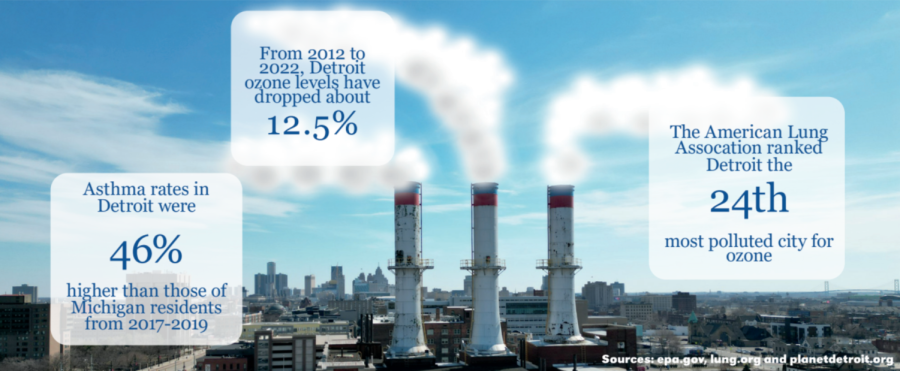Detroit ozone reaches dangerous levels: City fails to meet federal air standards
Photo credit: Annabelle Julien & Grace Rossman
April 11, 2023
The Detroit area has recently experienced increased air pollution, which has led to high levels of ozone in the atmosphere. This issue caused the Environmental Protection Agency, EPA, to reclassify Detroit as a moderately polluted area on Jan. 26, according to Regulations.gov. By moving Detroit from a “marginal” level to a “moderate” one, the EPA indicated that Detroit’s air pollution levels failed to meet federal standards.
Being moved to a moderate level by the EPA would require Detroit to follow additional regulatory standards to handle pollution issues. As a result, the Michigan Department of Environment, Great Lakes and Energy, EGLE, requested an exemption from these air pollution regulations, causing discourse in local communities. According to environmental science teacher Andrew Pola, one of the main reasons people are concerned about this decision is because of the health issues that air pollution is known to cause.
“We care about it because it causes respiratory problems,” Pola said. “Detroit already has some of the highest levels of asthma in the state, so there is already a disproportionate effect from this environmental stressor on the community.”
Pola introduced this topic to his AP Environmental Science class in early March, explaining the actions of EGLE and the impacts of their decision. Students from his class, including senior Zoey Crossley, are concerned with the effects of pollution on local populations that are already struggling with health problems associated with poor air quality.
“Detroit already has very bad air, which affects the health of children and people with asthma, [so] this is just going to make things a whole lot worse,” Crossley said. “The air does not just stay in Grosse Pointe, and it just doesn’t stay in Detroit. It will spread to other parts of the city and the country.”
However, there is another side to EGLE’s decision to request an exemption from federal regulations. According to Pola, EGLE defended its position by saying that due to wildfires that occurred in Canada, Detroit’s air pollution was pushed above the EPA’s standards. As of March 14, 2022, Detroit now meets the EPA’s standards for air pollution, which Pola says is because the EPA considers wildfires an exception when calculating air pollution levels.
“Even though we are above the ozone maximum level that is allowed by the federal government, [the state is] going to say that because these events are extraordinary, we do not have to resolve the problem,” Pola said.
Along with Pola, local meteorologist, and climate change expert Paul Gross also claims that increased pollution has led to respiratory problems for people in the Detroit area.
“If there is a lot of industry in an area, then air pollution can also be unhealthy to those with respiratory or other health problems,” Gross said. “This is most impactful on hot, humid days with little wind blowing to disperse the air pollution.”
With the effects of pollution in mind, Pola and Crossley believe that community members should get involved and contact lawmakers in order to make a change in their community. Crossley says individuals can sign petitions, join environmental advocacy groups and write messages to their local leaders in order to mitigate the impact of air pollution.
“I am a believer that everyone can make change,” Crossley said. “Legislators really need to take notice of the environmental issues that are plaguing the city.”










